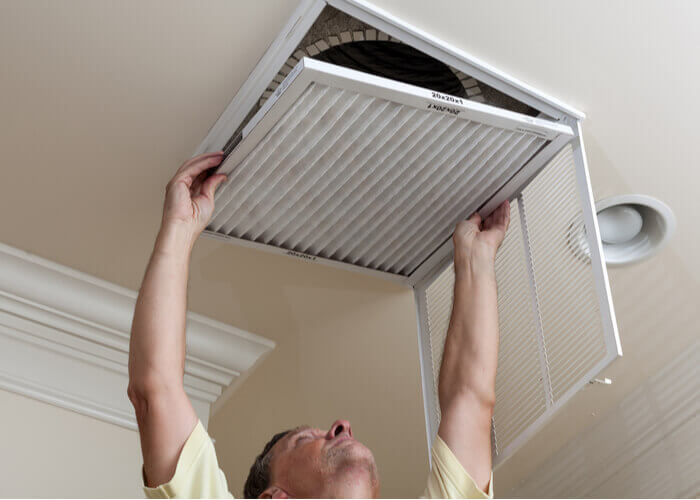Your electricity bill could increase by 10% or more when you work from home. Air conditioning costs are the biggest culprit, but you can also take steps to reduce your costs by enabling power-savings modes, using natural light, and setting up a dedicated workspace.
9 Home Office Ideas to Save on Your Electricity Bill
Use these tips to keep your electricity bill low while working from home. And, consider going solar to offset your increased electricity usage while working from home.
9 More Ways to Save on Electricity
Free download with more tips!
"*" indicates required fields
Tip #1: Keep your air conditioning set at 75-78° during the day.
If you are used to working in an office, you are used to working at around 72°. But you weren’t paying the bill.
For every degree you increase your thermostat during the summer, you could save 1% on your bill.
So, if your home is normally set at 72°, you can save 3-6% on your electricity bill by making this change.
Here’s how:
- Your family won’t protest as much if you change the temperature by one degree each day. That allows everyone to acclimate to the higher temperature.
- Dress appropriately for the outside weather, even if you are inside. Of course you need to keep it professional, but no one on the video call needs to know you are wearing shorts and flip flops.
- You can drop the air conditioning down to your normal levels at night. Since the temperature difference between inside and outside is lower at night, your A/C system won’t be working as hard to cool your home.

Tip #2 Use ceiling fans to cool down.
Panicked over having a 78° house during the day? Don’t be. Use ceiling fans to cool down.
Seriously, as I am writing this, a fan above my home office desk is giving a nice breeze on low. The thermostat is set at 78°. And I’m about to get a sweater.
According to Energy.gov, a ceiling fan will allow you to increase your thermostat setting by 4° with no reduction in comfort.
Here’s how:
- Ceiling fans cool through evaporation. Think of a cool breeze on a hot summer day. It’s the same thing.
- Set your ceiling fan to create a downdraft. This is the default setting on most ceiling fans. To check, confirm that your fan is running counter-clockwise.
- Make sure to turn off the ceiling fan when you leave the room.
Tip #3 Do a DIY HVAC Tune-Up.
Cooling your home accounts for around 50% of your electricity bill.
A professional HVAC tune-up is ideal, and HVAC services are considered essential services.
But a DIY HVAC tune-up is better than nothing.
Here’s how:
- Change your air filter.
- Clear the condensate drain (usually in your attic) and add a solution of 50% bleach/50% water to the access point to avoid mold or mildew.
- Remove grass, plants, sticks and leaves from your outside system
- Check your duct work for rips or sagging (and never patch it with duct tape!)
- Clean your outside evaporator coil using solution of dish washing soap, vinegar and distilled water.
Check out our article on 7 Best Spring Cleaning Tips for A/C Maintenance for detailed instructions.

Tip #4 Monitor your electricity plan for contract expiration dates.
If you are in a deregulated electricity market like Texas, Ohio, Connecticut and many others, make sure to monitor your electricity bill for your contract expiration date.
If your electricity contract has expired, you’re paying a month to month variable rate. Those rates can be 30-50% higher than what you would pay on a new contract. We always recommend a fixed rate electricity plan.
Check your electricity bill to confirm when your electricity supply contract expires.
Here’s how:
- If you live in Texas, your bill comes from a retail energy provider. The bill includes both your energy charges and your delivery charges. Review your bill to find an item that says, “You have a contract valid through <date>.”
- If you live in Ohio, Connecticut or another deregulated market, you’re receiving a bill from your local utility. On that bill, look for a line item that says “alternative supplier” or “supply charges.” You’ll find your expiration date there.
- If you can’t find the expiration date on your bill, check the name of the plan you are on. If it’s something like “Flex Plan” or “Month to Month Rate,” it means you are not in an electricity contract. You should shop for a new electricity plan.
- Use a comparison site like ElectricityPlans.com to shop for a fixed rate electricity plan for your home.
Bonus Home Office Idea: If you are on a free nights or free weekends electricity plan, consider whether you should switch to a fixed rate plan, now that you are home all the time.
Shop for Electricity for Your Texas Work From Home Office
Tip #5 Keep your refrigerator running efficiently by cleaning your refrigerator coils.
Cleaning the refrigerator coils? Is that even a thing?
Yes, it’s a thing. And now that you have a home office, the kitchen is part of your work environment.
Refrigerator coils, also called condenser coils, are the black coils found on the back or bottom of your fridge. If there’s a lot of dirt on the coils, your fridge will require more energy to cool your food.
You should clean them every year, or every 6 months if you have pets.
Here’s how:
- Unplug your refrigerator at the wall
- Locate the condenser coils. For an older fridge, it will be on the back. For newer refrigerators, there’s a panel on the bottom front of your fridge. Remove that and set it aside.
- Use a soft bristled brush to scrape dust and grime off the condenser coils. Or, refer to your refrigerator’s owner’s manual for instructions.
- Vacuum the condenser coils.
- Repeat brushing and vacuuming until the coils are clean.
- While you’re at it, vacuum under the fridge to remove ancient dust bunnies.
Tip #6: Set up your home office away from the afternoon sun, but make use of natural light.
You want to get the benefit of natural lighting. That’s proven to boost your mood and increase productivity. And it’s a home office idea that many lean toward.
But at the same time, many energy efficiency experts say you should keep your blinds closed in the summer, to keep out the thermal heat from the sun.
If you have flexibility on where you set up for working from home, you can do both.
Here’s how:
- In the northern hemisphere, the south side of our homes gets the most sun exposure. That’s the side of your home that is the hottest.
- Because of that, you ideally want to pick a room that’s on the north side of your home. If that’s not available, try for the east side of your home.
- Open the blinds in that room to get natural light, without heavy sun exposure and thermal heat.
Bonus Home Office Idea #1: Don’t forget! Keep in mind that any sunlight behind you will make you appear shadowy on your work from home video conferences.
Bonus Home Office Idea #2: Use a desk lamp to illuminate your face during video conferences.
Bonus Home Office Idea #3: Consider using a home office background screen or virtual background to give a more professional appearance.

Tip #7 Set up your computer for energy savings.
Computer manufacturers across the country cry at night, because you don’t use any of the power management features they built.
Just kidding.
But seriously, there are excellent power management tools in your computer that can help save on your electricity bill. You can also save with sleep mode, and a power strip.
Here’s how:
- To set up power management tools:
- On a Windows-based laptop, click on Start, then Control Panel, Power Options
- Change battery settings to Balanced or Low Power
- To set your computer’s screen and sleep mode:
- Click Start, Settings, System, Power & Sleep
- Under Screen, select how long you want your screen to remain lit when you are not using your device.
- Under Sleep, select how long you want the computer to wait before it goes into sleep mode, if you aren’t using it.
- A screen saver looks pretty, but doesn’t save your screen or electricity.
- Use a power strip for all your office electronics, and turn off the entire power strip when you are done for the day.
As to whether you should leave your laptop plugged in all day, or run off your battery, there are people (and manufacturers) in both camps.
Running your laptop off the charger all the time will result in your battery not holding a charge as long. But running your battery to zero will also damage it. Check with your IT department or the manufacturer to be sure of the correct approach.
Tip #8 Do a DIY Home Energy Audit
Since your home is temporarily your office, use your lunch break do do a quick DIY Home Energy Audit.
Here’s how:
- Check for air leaks around windows, doors and baseboards. You can do this by using the hand test (feel for leaks) or use the dollar bill test. For the dollar bill test, shut a door or window on a dollar bill. If you can easily pull it out, you’re losing energy there.
- Check for air leaks around electrical outlets and wall switches. Use the match test by holding a blown out match in front of the outlet or switch. If the smoke wavers, instead of rising in a smooth column, you have an air leak.
- Check for hot air escaping from your attic door, again by using the hand test to feel for leaks.
What do you do if you find any of these issues? You can find the fixed in our blog post, DIY Home Energy Audit for Energy Efficiency.
If you have to go to the hardware store for an essential item, you’ll be able to pick up what you need there.

Tip # 9: Involve your kids in energy conservation while you work from home.
If you have kids at home, you’re not only dealing with a work from home situation, you are also trying to home school and entertain the kids.
You might even be looking for math and science STEM curriculum to keep the kids busy.
Here’s how:
- Teach about saving towards a goal. Have your kids come up with a list of ways to save on electricity around the home, such as shutting off the television or lights. Assign each task a points value. When the kids have enough points, they’ve earned a treat!
- Measure your Carbon Footprint. Use our downloadable carbon footprint worksheet to check your home’s carbon footprint and ways you can improve to help the earth.
- Teach about kilowatt hours and what they power. Using information off the back of your electronics, kids can calculate how much electricity appliances in your home use. Once they finish, have them come up with a list of ways to conserve.
- Plan an earth day celebration. Earth day is April 22. Take the day to celebrate nature, by planting a butterfly garden , or making a milk-carton birdfeeder, or one of 13 Earth Day ideas. Or, pull out the paper plates, magic markets and popsicle sticks, to make paperplate flowers for some spring-time cheer.
Can Solar Panels Offset the Cost of Working from Home?
Working from home and remote work are here to stay. And so are higher electricity bills. Researchers say work-from-home increases electricity bills from around 10%. When you’re home all day, you are heating or cooling your home, using appliances more often and using computers and electronics.
With rising electricity prices in Texas, and the higher energy costs of work from home, it’s a great time to look at rooftop solar for your home. Rooftop solar can replace most of your electricity needs during the daytime. And if you produce excess energy on days that you go into the office, you can sell it back onto the grid with a solar buyback electricity plan.
ElectricityPlans.com has partnered with Freedom Solar Power, the number one installer of SunPower solar panels in Texas. You can receive a full, no obligation review of your rooftop’s solar potential and your return on investment.
